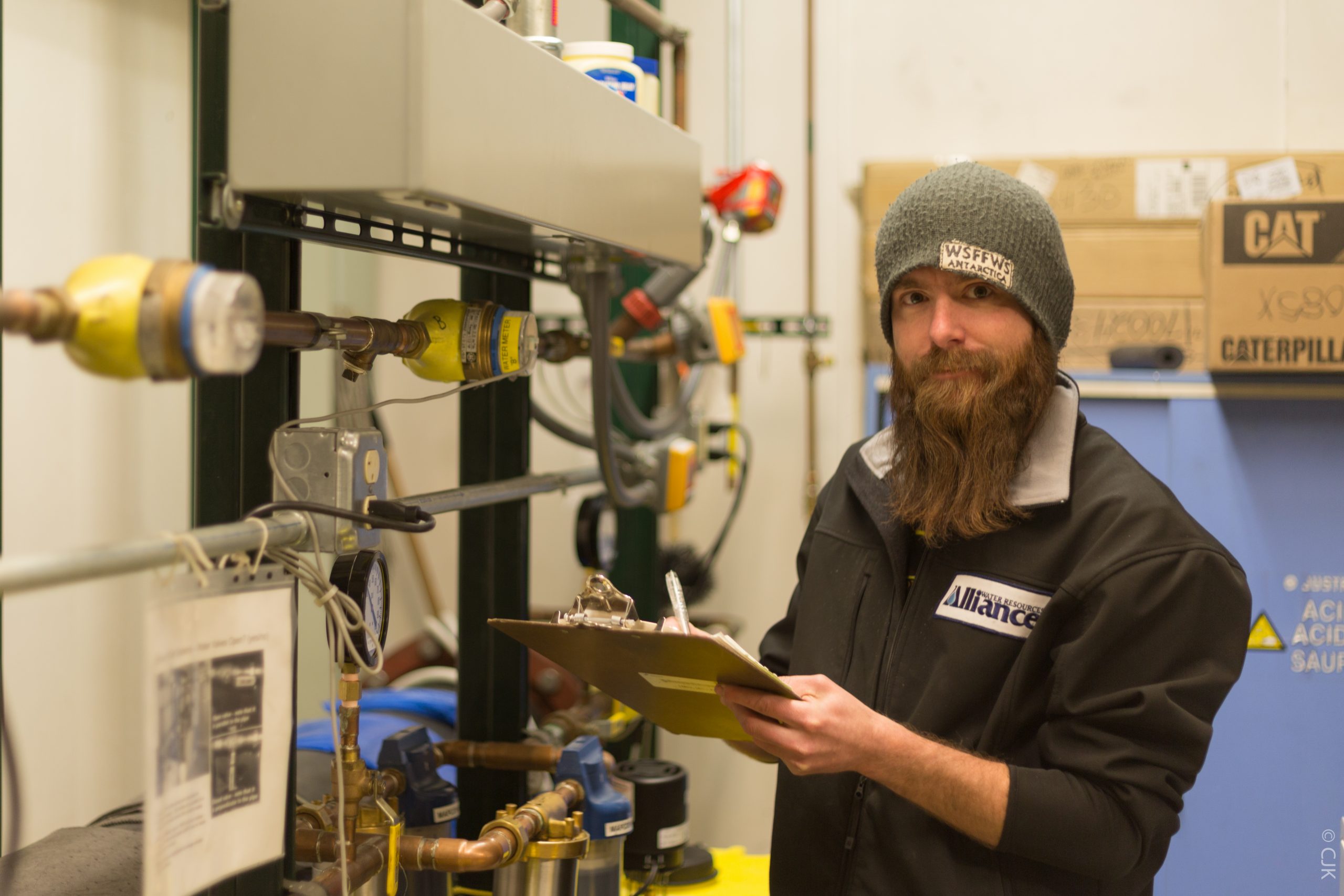It’s been 108 years since people first set foot on the geographic South Pole in Antarctica. Two years ago, Notre Dame alumnus William Lindman (‘05) did the same, serving as a water plant operator at the Amundsen-Scott South Pole Station – a scientific research base – for nearly ten months.
Lindman’s desire to travel to the bottom of the world came after his graduation from Lindenwood University, during his time with the Peace Corps in Uganda. Here, he served as a water sanitation volunteer for a little over two years, then he headed back home to work for the city water plant in Cape Girardeau.
When he was looking for a new job three years later, Lindman settled into the habit of watching Netflix documentaries while he worked on his resume. “A Year On Ice” – which chronicles one man’s isolated journey of living for a year in Antarctica – began playing one night, and again piqued his interest.
“I put everything down and started watching it. There were all of these people on Antarctica, and I thought, ‘They have to have water personnel there, right?’” said Lindman. “I did a Google search and sure enough, there were some open positions.”
Since the summer season was ending, he was quickly hired for the research station’s winter personnel, and flew out in January of 2016.
A Small Civilization
Although it was winter back in the states, it was the end of summer and a balmy 40 degrees below zero in Antarctica when Lindman arrived. Transitioning seasons, the population at the base dropped along with the temperature, from 150 people to a skeleton crew of about 50. They had everything from carpenters to plumbers, from IT professionals to physicians. Collectively, their job was to keep the facility operational and to maintain projects until the summer crew could return.
“I’d like to compare it to everything that makes a community work, so it was quite a variety of backgrounds,” said Lindman. “It was pretty interesting to see how we were able to work together without really knowing each other.”
With the variety of people came a variety of nationalities, too. It was a U.S. base, but they had personnel from Germany, Canada, and New Zealand. Lindman said there were about seven scientists among the crew. Some were monitoring air quality and ozone restoration, while others were working on the South Pole Telescope (SPT).
“Essentially, the South Pole is the only place in the world where you can look at one section of sky for a continuous amount of time, due to Earth’s rotation,” said Lindman. “They’re able to look so far back into the universe to try and understand the origins of the Big Bang – that sort of thing.”
In the summer months, more research is conducted on space through a program nicknamed “Ice Cube,” where scientists at the station send probes into a square-mile block of ice in search of a particle called “neutrinos.”
“I know there was a lot of core sampling going on, too,” said Lindman.
Burning The Midnight Ice
Lindman’s main responsibility as a water systems operator at the base was ensuring safe drinking water for their personnel. The first step in that process was to melt ancient ice.
“We were essentially cleaning water that was estimated to be around 2,000 years old,” said Lindman. “We were monitoring it and adding a small amount of chemicals to bring the pH level up to what humans can consume.”
He monitored the system with regulations set by the Department of Natural Resources, most of them requiring Lindman to “just record a lot of numbers.”
“I had to keep track of how much chemical we were using, what the water flows were, making sure our chemicals were actually pumping correctly, and grabbing samples throughout the station to make sure weren’t actually losing water anywhere,” said Lindman.
In Antarctica, the sun rises and sets once a year, and the majority of Lindman’s term took place during the night: eight months of darkness.
“All the windows were boarded up to prevent light pollution from exiting the station, because we had all of these cameras set up, capturing the auroras and star patterns,” said Lindman. “So it was pretty interesting to be in a building that you’re not seeing the sunlight at all. It’s not something you’re used to.”
Before working at the station, employees are required to go through psychological training and medical screenings to ensure they’re able to handle the isolation. Lindman fared fine, despite his nocturnal work hours.
“I was working the midnight to 8 a.m. shift, so when most of the station was sleeping, I was awake. And when I was getting off work, the station was getting ready to go to work. So I didn’t have much interaction with people,” said Lindman. “That was kind of weird, because you can’t really base your sleep schedule off of your circadian rhythms. It’s constantly dark, and breakfast was my main meal.”
With a low of negative 108 degrees, layering up became second nature for Lindman. This included the stereotypical, oversized, red coats people wear in pictures when you Google “Antarctica.” And, keeping his gear with him in the event of an emergency was a lesson he learned quickly.
“There were a couple of times that an alarm came in the middle of the night that I was a first responder to, since I was one of the two people who were up at that time,” said Lindman. “Once, there was a low oxygen alarm in the cryogenics building – that’s where they do the core sampling. I went out there and I had most of my gear, but not all of it. It got really cold.”
Back To Sunshine
Coming home proved to be a bit of a culture shock for Lindman. It was nice to eat a lot of food and meet with friends, but one basic task stood out to him immediately upon his return.
“At the end of the season, I remember flying into Chicago and renting a car to get to a job interview up north,” said Lindman. “But I realized I hadn’t actually driven a car in like, ten and a half months now. I literally had only been walking. I remember putting the car in reverse to back out of the spot, and going back and forth.”
Although there are parts of him that miss Antarctica, Lindman would most likely turn down an offer to go back. Being there was a challenge, especially when he missed out on events, weddings, and time with family and friends.
“I’m almost 30 years old and I’m married now, so it would be hard to change all that,” said Lindman. “I remember the day I was leaving, I was with a group of people waiting for the plane and I wandered off by myself. I sat looking at the horizon, and I was thinking to myself, ‘This will probably be the last time you will ever see this.’ You know, I can go anywhere in the world, but this place is a challenge to get to, and I said my goodbyes then.”
The Notre Dame Effect
Reflecting on how Notre Dame has played a role in his personal growth, Lindman recalled one summer in particular where he had gotten himself into a bit of trouble.
“I was grounded for the entire summer, and Brother David found out about that. There was a mission trip to St. Louis coming up, so he called and asked, ‘I know you’re not doing much, so what about going on this trip?’” said Lindman.
He agreed, and even had a great time.
“It sparked my interest in travelling and in serving others, which my parents had already instilled in me, but I was thinking, ‘Yeah, I could do more.” said Lindman.
Sometimes Lindman wonders what would’ve happened if he hadn’t been reached out to that summer. Would his life have been completely different? He thinks so.
“The friends I made there were all so supportive of my life of service. My best friend, who graduated with me in 2005, we talk every couple of days and even send care packages,” said Lindman. “I think Notre Dame definitely gave me a lasting impact for my future, and I’m extremely grateful for that.”
Lindman now works in water treatment in Manitowoc, Wisconsin, and travels regularly with his wife. The 29-year-old is angling to set foot on every Earthly continent, and he has just one more to go: Asia.



